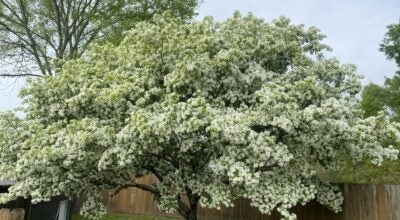Winter Weed Control
Published 12:06 am Sunday, January 19, 2014
During this time of the year, all of the southern warm season turfgrasses have gone dormant to cope with the cool conditions. Although the turfgrasses have gone inactive, weed species are still rampant in their quest to overtake the lawn. As a result, many turf areas are being overwhelmed by cool season weeds. Some of the cool season weed species that are present are white clover, henbit, annual bluegrass, Florida betony, and lawn burweed among others.
White clover (Trifolium repens) is a low growing, broadleaf perennial. The foliage is trifoliate, which means that each leaf is composed of three leaflets, and each leaflet is distinctly marked with a white band. Due to its low growing stature, rooting occurs at nodes along the stems, and this allows the white clover to become established easily. White clover produces flowers that are white in color with the flowers being arranged in a conspicuous round head. White clover reproduces by seed.
Henbit (Lamium amp-lexicaule) is a broadleaf winter annual that contains stems that are square and greenish to purple in color. Leaves are arranged opposite on the stem and are broadly egged shaped with a toothed margin. The henbit produces flowers that are purplish to red in color, and it reproduces by seed.
Annual bluegrass (Poa annua) is a winter annual that exhibits a clumping habit. It is a true grass which is reflected in its name bluegrass, but it is not as desirable as its relative the Kentucky bluegrass (Poa pratensis), which is used as a cool season turfgrass in northern states. This grassy weed is a persistent winter weed. The leaf blade is smooth on both sides, and the blade tip is boat shaped. Light green to whitish spikelets are produced in a panicle inflorescence which is a defining identification characteristic.
Florida betony (Stachys floridana) is also known as rattlesnake weed, and it is a cool season perennial that has square stems. The foliage is arranged opposite on the stem, and the leaves are long stalked and lance shaped with a nearly flat base. Flowers are produced, which are white to pink in color. The plant also produces white tubers underground which resemble a “rattlesnake’s rattle” hence the common name rattlesnake weed. The tubers are the main method of propagation for this weed.
Lawn burweed (Soliva sessilis) is commonly referred to as stickerweed or spurweed. It is a small, low growing annual that has foliage that resembles miniature parsley. Unlike the other winter weeds that have been mentioned, lawn burweed is rather inconspicuous in the lawn during the vegetative stage of growth. As the temperatures begin to increase in the spring, the lawn burweed begins undergoing the reproductive stage of growth. The fruiting structures, small rosette buttons, develop in the leaf axils. As the fruit matures, the seed in the fruiting structures develop spines, and when the fruit becomes dry, the spines become very sharp. These sharp spines are what make the lawn burweed so famous because nearly everyone has stepped across a turf area with lawn burweed present while being poked by the sharp spines. As a result, controlling the lawn burweed before fruit development is critical in preventing the spiny seed from developing.
If you are experiencing some problems with these cool season weeds, some herbicides are available to control these weeds. Atrazine is one of the active ingredients that is very effective in controlling broadleaf and grassy winter weeds, and atrazine is available in numerous brand names. Also, herbicides containing 2,4-D along with additional ingredients such as dicamba, mecoprop, and carfentrazone are effective in controlling broadleaf winter weeds. Some of the products available with 2,4-D and the additional active ingredients include but are not limited to Ferti-lome Weed Free Zone, Ortho Weed B Gon Max for Southern Lawns, Ferti-lome Weed Out, and Trimec. When using a herbicide or any other pesticide product, always read and follow the product label.
This article was compiled by Scotty May, Assistant Extension Agent (ANR) for Washington Parish. The reference of brand names in this article is not an endorsement of these products because the LSU AgCenter does not endorse specific pesticide brands. For more information concerning this article or related topics, please contact the Washington Parish Extension Office at 985-839-7855.





